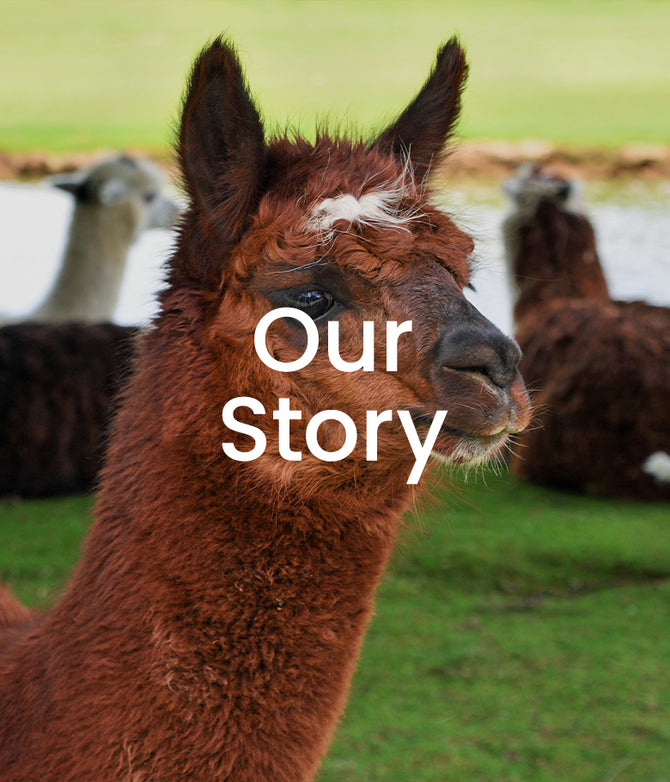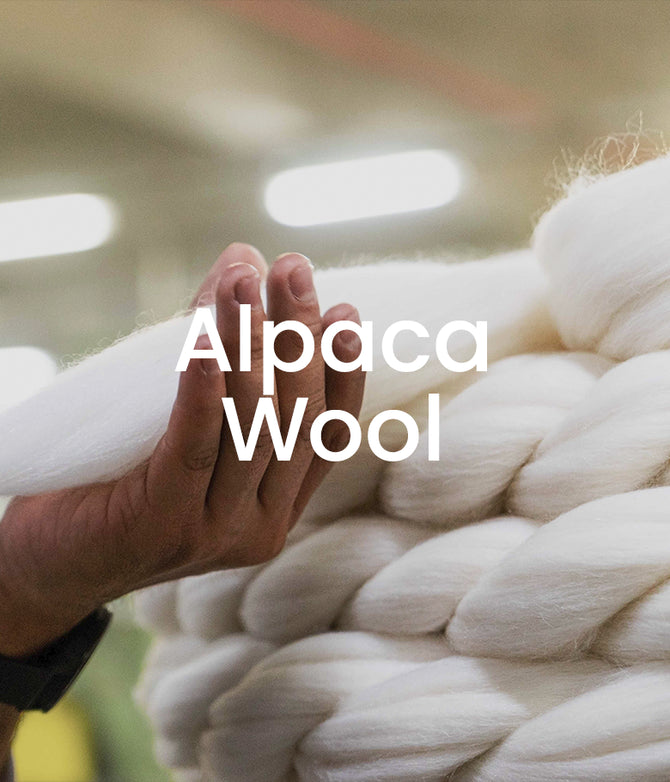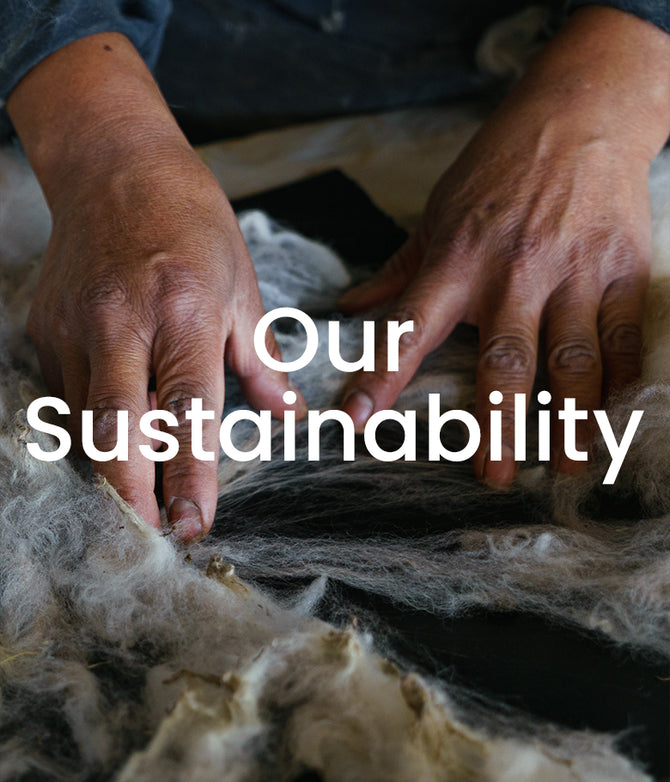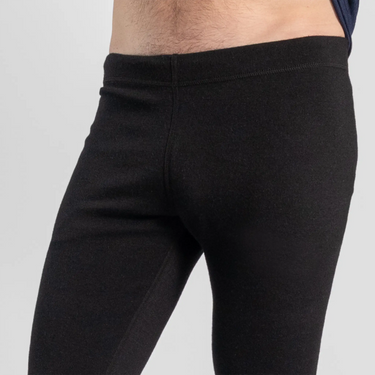PFAS: The "Forever Chemicals"
Hidden in Your Clothes
Published March 18, 2025
1. Say Goodbye to Single-Use Plastics
Single-use plastics are a huge environmental problem, but small tweaks in your daily habits can make a big difference:
- Bring reusable bags: Make or buy groceries and produce bags to use instead of plastic ones. Keep them by the door or in your car so you never forget them.
- Ditch bottled water: Invest in a reusable water bottle [1]. If tap water isn’t safe, boil or filter it instead.
- Carry a reusable coffee cup: Even “eco-friendly” disposable cups create waste if not disposed of properly.
- Pack a zero-waste kit: Include bamboo or metal cutlery, a reusable straw, and a container for takeout. It might take practice, but soon it’ll feel natural.
2. Use Less Water and Energy
Every drop counts, and every watt matters. Here are a few small changes to reduce your footprint:
- Shorten your showers: A quick shower saves both water and energy. Bonus: it’s better for your skin too! [2]
- Turn off the lights: Unplug appliances and switch off lights when you’re not using them [3].
- Hang clothes to dry: Whenever possible, skip the dryer and hang your clothes. It’s gentler on fabrics and the planet.
- Flush smarter: If your toilet has an eco-flush option, use it. No eco-flush? Place a filled bottle in the tank to reduce water per flush.
At Arms of Andes we make our gear from 100% Royal Alpaca Wool of 18-18.5 microns.
3. Make Eco-Conscious Food Choices
Food is one of the easiest ways to live more sustainably:
- Buy local and seasonal: This reduces transportation emissions and supports local farmers [4].
- Cook from scratch: Homemade meals usually come with less packaging and waste.
- Be mindful about meat: Choose ethically raised options, like free-range chicken or grass-fed beef, and support sustainable farming practices. Exploring plant-based meals occasionally can also make a difference [5].
- Opt for sustainable groceries: Shop at packaging-free or bulk stores. No access? Buy in bulk at your regular store to minimize waste.
4. Rethink Your Transportation Habits
How you get around affects your carbon footprint. Start small:
- Walk or bike more: Even once a week can make a difference.
- Use public transport: Replace car trips with bus or train rides when possible [9].
- Carpool: Sharing rides with colleagues or friends reduces emissions.
- Fly less: For shorter trips, consider buses or trains. Offset your carbon emissions for long flights.
5. Choose Sustainable Fashion
The fashion industry is one of the largest polluters, but your wardrobe can make a difference:
- Avoid fast fashion: Look for quality over quantity. Cheaper often means corners were cut in ethics and sustainability.
- Buy second hand: Thrift stores and online resale platforms are great for finding unique, affordable items.
- Support eco-conscious brands: Do your research and choose brands that prioritize sustainability, like Arms of Andes, which uses 100% alpaca wool and natural dyes [6].
- Host clothing swaps: A fun way to give new life to unused items in your closet [7].

6. Upgrade Your Hygiene and Cleaning Habits
Small changes to your personal care and cleaning routines can have a big impact:
- Switch to bamboo* toothbrushes: Look for ones with compostable bristles and packaging.
- Choose steel razors: A durable, waste-free alternative to disposable razors.
- Use natural options: Biodegradable shampoos, soaps, and detergents are better for the planet.
- Use menstrual cups and fabric sanitary towels: They take a little getting used to, but you won’t go back when you do!
- Clean with vinegar and baking soda: These simple ingredients work wonders around the house and are free of harmful chemicals [8].
* When choosing products made from bamboo, try to ensure the bamboo comes from sustainable sources.
7. Embrace Nature and DIY Solutions
Spending time outdoors and trying DIY solutions are both fun and sustainable:
- Grow your own vegetables: Even a small herb garden on a windowsill can make a difference.
- Start composting: Turn food scraps into nutrient-rich compost for your garden. No garden? Check if your city collects food waste.
- Connect with nature: Spending time outside reduces stress and reminds us why protecting the planet matters.
- Join community initiatives: Participate in clean-ups or tree-planting events.
8. Be Mindful About Waste
Rethinking how you handle waste is key to sustainable living:
- Reuse before you recycle: Find new uses for things before throwing them away.
- Donate or swap: Let someone else enjoy what you no longer need.
- Avoid expedited shipping: One-day deliveries often mean more vehicles on the road, increasing emissions.
Sustainable living starts with REDUCING waste, REPAIRING and/or REUSING broken/unused items, before RECYCLING or, when possible, COMPOSTING them.
Why Small Steps Matter
You might think, “Will my tiny changes really help?” The answer is yes. If everyone made just one or two of these adjustments, the collective impact would be enormous. And remember, you don’t have to do everything at once. Pick a couple of these tips to start with, and add more as you go. Before you know it, living sustainably will feel like second nature.
So, are you ready to make 2024 your most sustainable year yet? Small steps today can lead to a greener tomorrow. Let’s get started—one habit at a time!

At Arms of Andes we make our gear from 100% Royal Alpaca Wool of 18-18.5 microns.
Reading time: 6 minutes
By Lesia Tello & Jordy Munarriz
When we think of our favorite outdoor jacket or waterproof hiking boots, we often marvel at their durability and performance. But did you know that many of these garments might contain chemicals with lasting impacts on our health and the environment? Meet PFAS—perfluoroalkyl and polyfluoroalkyl substances—commonly referred to as "forever chemicals."
What Are PFAS and Where Do They Hide?
PFAS are a group of synthetic compounds used since the 1950s to make materials water-repellent, stain-resistant, and non-stick [1]. These compounds have been widely adopted in industries ranging from cookware and food packaging to textiles, where they are commonly found in outdoor gear, sportswear, and waterproof clothing [2].
PFAS are notorious for their persistence in the environment—and unfortunately, in our bodies. They have an incredibly strong chemical structure that makes them resistant to breakdown [1]. Once released, they can linger in the environment for decades or even centuries, leading to bioaccumulation in living organisms and contamination in water and soil [3,4,5,6]. In humans, PFAS have a half-life of over five years, meaning it takes that long for just half of the substance to be eliminated from the body [7].
Pathways of direct human per- and polyfluoroalkyl substance (PFAS) exposure and its potential health effects [2]
The Health Risks of PFAS
The bioaccumulation of PFAS in our bodies is a growing concern. These chemicals can enter through skin contact, inhalation, or ingestion—think contaminated drinking water or food [1,8]. Studies suggest that prolonged exposure to PFAS may lead to:
- Higher cholesterol levels [9]
- Increased blood pressure [10]
- Risk of kidney disease [11]
- Birth defects and developmental delays [12,13,14]
- Preeclampsia in pregnant women [15,16]
- Potential links to cancer (though more research is needed) [17,18,19]
The scary part? Almost everyone on the planet has some level of PFAS in their blood. Shockingly, studies have shown that up to 99% of analyzed human blood samples contain detectable levels of PFAS, raising significant health concerns [20,21].


6. Upgrade Your Hygiene and Cleaning Habits
Small changes to your personal care and cleaning routines can have a big impact:
- Switch to bamboo* toothbrushes: Look for ones with compostable bristles and packaging.
- Choose steel razors: A durable, waste-free alternative to disposable razors.
- Use natural options: Biodegradable shampoos, soaps, and detergents are better for the planet.
- Use menstrual cups and fabric sanitary towels: They take a little getting used to, but you won’t go back when you do!
- Clean with vinegar and baking soda: These simple ingredients work wonders around the house and are free of harmful chemicals [8].
* When choosing products made from bamboo, try to ensure the bamboo comes from sustainable sources.
7. Embrace Nature and DIY Solutions
Spending time outdoors and trying DIY solutions are both fun and sustainable:
- Grow your own vegetables: Even a small herb garden on a windowsill can make a difference.
- Start composting: Turn food scraps into nutrient-rich compost for your garden. No garden? Check if your city collects food waste.
- Connect with nature: Spending time outside reduces stress and reminds us why protecting the planet matters.
- Join community initiatives: Participate in clean-ups or tree-planting events.
At Arms of Andes we make our gear from 100% Royal Alpaca Wool of 18-18.5 microns.

PFAS in Your Clothes: The Good, the Bad and the Ugly
Fashion is one of the main culprits when it comes to PFAS exposure. Outdoor clothing, sportswear, and even some upholstery are treated with PFAS to enhance durability and resistance. But as these garments age or are exposed to washing, sunlight, or heat, PFAS leach out, contaminating our environment [22,23].
Even more concerning is the indirect use of PFAS in textile production. Some dyes and finishing processes unintentionally introduce these chemicals into supposedly PFAS-free products. For instance:
- Reactive dyes: Often use polyamide, a material known to contain PFAS, to protect fabrics during the dyeing process [24].
- Finishing treatments: Flame retardants, water repellents, and stain-resistant coatings frequently involve PFAS [1].

Fighting Back: Global Legislation and Regulations
Recognizing the dangers of PFAS, governments and organizations worldwide are stepping in. Here’s a quick look at some key initiatives:
- European Union: In 2007, the REACH program began regulating toxic substances, including PFAS. The EU is now considering a total ban on PFAS by 2026 [25,26,27,28].
- United States: Recent measures include the Clean Drinking Water Act (2022) and a proposed nationwide PFAS limit in water by the EPA [29,30].
- Asia: Countries such as China and Japan have implemented partial bans, but their enforcement remains inconsistent and below what is expected of world powers [31,32].
Despite these efforts, the fight is far from over. Many textile-producing countries still lack stringent regulations, allowing PFAS contamination to persist.
At Arms of Andes we make our gear from 100% Royal Alpaca Wool of 18-18.5 microns.
160 Ultralight
Men's Alpaca Wool
Hoodie
300 Lightweight Half-ZipWomen's Alpaca Wool Leggings 300
Lightweight

For snowboarders, skiers, and winter hikers, weight matters. Every gram counts when you're climbing, carrying gear, or navigating the slopes. Alpaca wool’s unique insulation properties allow for lightweight warmth, meaning you stay protected without unnecessary bulk.
Five Reasons to Choose Alpaca Wool for Snow Sports
Alpaca wool is the ultimate base and mid layer material for tackling the demands of skiing and snowboarding. Its unique properties make it an exceptional choice for base and mid layers, ensuring comfort and performance on the slopes.
1. Exceptional Warmth
Alpaca wool fibers feature semi-hollow cores, providing incredible insulation. Combined with their natural crimp (waviness), these fibers trap heat efficiently,
2. Breathable and Moisture-Wicking
One of alpaca wool’s standout qualities is its ability to wick moisture away from your skin while remaining highly breathable. This means you stay dry and comfortable, even during intense physical activity. Alpaca wool base layers, such as leggings and shirts, excel in keeping you warm and sweat-free.
3. Temperature Regulation
Alpaca wool’s unique ability to balance warmth and breathability helps regulate your body temperature. Whether you're racing downhill or waiting for the ski lift, alpaca wool keeps you warm in the cold and prevents overheating during activity.
4. Lightweight and Flexible
Thanks to its excellent insulating properties, alpaca wool keeps you warm without adding bulk. This lightweight quality ensures freedom of movement—crucial for maintaining balance and agility on the slopes.
At Arms of Andes we make our gear from 100% Royal Alpaca Wool of 18-18.5 microns.
Men's Alpaca Wool Jacket
420 Midweight Full-Zip

Relatedcontent
Bamboo:
A fast-growing plant often used for making sustainable products like toothbrushes and cutlery.
Biodegradable:
Materials that can break down naturally without harming the environment.
Bulk stores:
Shops where you can buy products in large quantities, often with minimal packaging.
Carbon footprint:
The total amount of greenhouse gases produced directly or indirectly by human activities.
Composting:
A process where organic waste decomposes into nutrient-rich material for gardening.
Ethically raised:
Livestock or poultry that is raised in humane and environmentally responsible ways.
Fast fashion:
Cheap, mass-produced clothing often linked to environmental and ethical issues.
Natural dyes:
Coloring substances derived from plants, animals, or minerals, used to color fabrics sustainably.
A Brighter Future: Alternatives to PFAS
The good news is that innovative alternatives are emerging to replace PFAS in textiles:
- Silicone-based finishes: Offer water resistance without harmful chemicals [33].
- Paraffin waxes and polylactic acid (PLA): Provide environmentally conscious options for water-repellent treatments [34].
- Gore-Tex membranes: While not perfect, these PFAS-free materials block water and are being adopted by forward-thinking brands [35,36].
- Sustainable pioneers: Companies like Archroma and Solvay are developing cutting-edge, PFAS-free technologies for textiles [37,38]
What Can You Do?
As a conscious consumer, you have the power to make a difference. Here’s how:
- Check labels: Look for brands that explicitly state their products are PFAS-free.
- Spread awareness: Share this knowledge with friends and family to encourage informed choices.
- Support sustainable brands: Companies investing in safer alternatives deserve your support.
PFAS may be invisible, but their impact is anything but. From polluting our environment to endangering our health, these chemicals remind us that sustainability isn’t just about reducing waste—it’s about rethinking how and why we produce.
The Arms of Andes Commitment
At Arms of Andes, we take sustainability seriously. Our outdoor apparel is crafted from 100% alpaca wool, a natural fiber that’s naturally water-resistant, breathable, and durable—delivering performance without harmful chemicals. We also use natural dyes, ensuring every step of our production process aligns with our commitment to the planet.
By choosing alpaca wool, you reduce exposure to harmful chemicals while supporting a cleaner, healthier environment.
Are you ready to rethink what’s in your closet? Explore the difference with Arms of Andes—because the future of sustainable fashion starts with you.


Glossarykeywords
Bioaccumulation:
The gradual build-up of substances, like PFAS, in the tissues of living organisms over time due to prolonged exposure.
EPA (Environmental Protection Agency):
A U.S. government agency responsible for protecting human health and the environment. Implements regulations to limit PFAS in drinking water and consumer products.
Finishing Treatments:
Chemical treatments applied to textiles to enhance properties like water repellency, stain resistance, or flame retardancy. Often involve the use of PFAS.
Flame Retardants:
Chemical treatments used in textiles to reduce flammability. Often associated with PFAS in durable finishes.
Half-Life:
The time it takes for half of a substance, such as PFAS, to be eliminated from the body. For PFAS, the half-life in humans can exceed five years.
Paraffin Waxes:
A natural alternative to PFAS used in textile treatments to provide water repellency.
Polylactic Acid (PLA):
A biodegradable polymer derived from renewable resources like corn starch or sugarcane, used as an alternative in water-repellent textile finishes.
Polyamide:
A synthetic polymer used in textile dyeing processes to protect fabrics. Known to sometimes contain PFAS, raising concerns about indirect exposure.
REACH (Registration, Evaluation, Authorization, and Restriction of Chemicals):
A regulatory framework established by the European Union in 2007 to ensure the safe use of chemicals in manufacturing and protect human health and the environment.
Reactive Dyes:
A type of dye used in textiles that chemically reacts with fibers to create a permanent bond. Sometimes associated with PFAS due to the use of polyamide during the dyeing process.
Silicone-Based Finishes:
A PFAS-free option used in textiles to provide water resistance and durability without harmful environmental or health effects.
At Arms of Andes we use the finest Royal Alpaca Wool sourced in the Peruvian Andes. The Andean alpacas naturally developed over thousands of years in harsh conditions in high altitudes, creating the perfect fiber for outdoor gear that helps you stay protected in all conditions. Discover our outdoor apparel.

In the textile industry, companies that produce garments made entirely from Merino wool typically use fibers that are 17.5 microns or finer to minimize any itchiness or roughness, [4] ensuring comfort for their customers. A study conducted by the Division of Dermatology at the University of Louisville in 2019 evaluated the effects of wearing these garments on individuals with skin sensitivities, such as atopic dermatitis or eczema. In the study, 25 participants wore only Merino wool garments of 17.5 microns for six weeks and cotton garments of 21 microns for six weeks more, while another group of 25 followed the reverse order. Participants reported significant changes when switching from cotton to Merino wool, with those who started in Merino wool experiencing a decrease in their eczema during the first weeks. [4]
| Properties | Royal Alpaca Wool | Cashmere | Merino Wool |
|---|---|---|---|
| Weight | Lightest | Light | Heavier |
| Fiber Structure | Semi-Hollow | Solid | Solid |
| Thermal Capacity | 5 x Warmer | 3 x Warmer | Warm |
| Water Retention | Absorbs 10% of weight | Shrinks in water | Absorbs 10%
of weight |
| UV Protection | Yes | Yes | Yes |
| Fiber Scales | Smoothest | Softest | Prickly |
| Microns (average) | 17.5 | 14 | 18 |
| Tensile Strength | Highest | Weak | High |
| Odor Resistance | Yes | Yes | Yes |
| Wrinkle Resistance | Yes | Yes | Yes |
| Hypoallergenic (Lanolin free) | Yes | Yes | No |
The Final Verdict: And the Winner Is...
After a comprehensive analysis of alpaca, merino, and cashmere, it's clear that cashmere, while undeniably luxurious, lacks the durability required for outdoor garments. However, it excels as a high-end fiber for special occasions and elegant attire.
In the head-to-head battle between alpaca and merino, alpaca emerges as the undisputed champion! Alpaca wool surpasses merino in warmth, lightness, softness, and strength. It's the ultimate choice for those seeking performance, comfort, and sustainability.
Authors & Researchers

Lesia tello
Biologist and hiking enthusiast with a deep admiration for nature and the intricate mechanisms of life. With a background in biochemistry and a master’s degree in education, she blends science with adventure, exploring how we interact with the natural world and sharing insights on outdoor experiences.

Jordy Munarriz
Environmental Engineer with a master’s degree in renewable energy and a specialization in sustainability. A passionate traveler and advocate for responsible tourism, he captures the essence of exploration through storytelling, inspiring others to connect with nature in a conscious and meaningful way.
Authors & Researchers

Lesia tello
Biologist and hiking enthusiast with a deep admiration for nature and the intricate mechanisms of life. With a background in biochemistry and a master’s degree in education, she blends science with adventure, exploring how we interact with the natural world and sharing insights on outdoor experiences.

Jordy Munarriz
Environmental Engineer with a master’s degree in renewable energy and a specialization in sustainability. A passionate traveler and advocate for responsible tourism, he captures the essence of exploration through storytelling, inspiring others to connect with nature in a conscious and meaningful way.
Alpaca wool (particularly the royal and baby alpaca fiber grades) is non-itchy, warm, and performs better than merino and other types of sheep's wool. This makes alpaca wool perfect for your outdoor clothing, slipper socks, and even underwear.

Glossarykeywords
EPA (Environmental Protection Agency):
A U.S. government agency responsible for protecting human health and the environment. Implements regulations to limit PFAS in drinking water and consumer products.
Paraffin Waxes:
A natural alternative to PFAS used in textile treatments to provide water repellency.
Flame Retardants:
Chemical treatments used in textiles to reduce flammability. Often associated with PFAS in durable finishes.
Polylactic Acid (PLA):
A biodegradable polymer derived from renewable resources like corn starch or sugarcane, used as an alternative in water-repellent textile finishes.
REACH (Registration, Evaluation, Authorization, and Restriction of Chemicals):
A regulatory framework established by the European Union in 2007 to ensure the safe use of chemicals in manufacturing and protect human health and the environment.
Silicone-Based Finishes:
A PFAS-free option used in textiles to provide water resistance and durability without harmful environmental or health effects.
References:
[1] Newland, A., Khyum, M. M., Halamek, J., & Ramkumar, S. (2023). Perfluoroalkyl and polyfluoroalkyl substances (PFAS)—Fibrous substrates. TAPPI J, 22(9), 559-572. https://doi.org/10.32964/tj22.9.559
[2] Meegoda, J. N., Kewalramani, J. A., Li, B., & Marsh, R. W. (2020). A review of the applications, environmental release, and remediation technologies of per-and polyfluoroalkyl substances. International journal of environmental research and public health, 17(21), 8117. https://doi.org/10.3390/ijerph17218117
[3] Olsen, G. W., Huang, H. Y., Helzlsouer, K. J., Hansen, K. J., Butenhoff, J. L., & Mandel, J. H. (2005). Historical comparison of perfluorooctanesulfonate, perfluorooctanoate, and other fluorochemicals in human blood. Environmental health perspectives, 113(5), 539-545. https://doi.org/10.1289/ehp.7544
[4] Olsen, G. W., Mair, D. C., Church, T. R., Ellefson, M. E., Reagen, W. K., Boyd, T. M., ... & Zobel, L. R. (2008). Decline in perfluorooctanesulfonate and other polyfluoroalkyl chemicals in American Red Cross adult blood donors, 2000− 2006. Environmental science & technology, 42(13), 4989-4995. https://pubs.acs.org/doi/full/10.1021/es800071x
[5] Demberger, A. Shoe production PFAS contamination leads to $113 million settlement. Risk & Insurance, 10 November 2022. Available Online https://riskandinsurance.com/shoe-production-pfas-contamination-leads-to-113-million-settlement/
[6] Venkatesan, A. K., & Halden, R. U. (2014). Loss and in situ production of perfluoroalkyl chemicals in outdoor biosolids–soil mesocosms. Environmental research, 132, 321-327. https://doi.org/10.1016/j.envres.2014.04.024
[7] Lee, J. E., & Choi, K. (2017). Perfluoroalkyl substances exposure and thyroid hormones in humans: epidemiological observations and implications. Annals of pediatric endocrinology & metabolism, 22(1), 6. https://doi.org/10.6065/apem.2017.22.1.6
[8] Nilsson, H., Kärrman, A., Rotander, A., van Bavel, B., Lindström, G., & Westberg, H. (2010). Inhalation exposure to fluorotelomer alcohols yield perfluorocarboxylates in human blood?. Environmental science & technology, 44(19), 7717-7722. https://pubs.acs.org/doi/abs/10.1021/es101951t
[9] Andersen, M. E., Hagenbuch, B., Apte, U., Corton, J. C., Fletcher, T., Lau, C., ... & Longnecker, M. P. (2021). Why is elevation of serum cholesterol associated with exposure to perfluoroalkyl substances (PFAS) in humans? A workshop report on potential mechanisms. Toxicology, 459, 152845. https://doi.org/10.1016/j.tox.2021.152845
[10] Pitter, G., Zare Jeddi, M., Barbieri, G., Gion, M., Fabricio, A. S., Daprà, F., ... & Canova, C. (2020). Perfluoroalkyl substances are associated with elevated blood pressure and hypertension in highly exposed young adults. Environmental health, 19, 1-11. https://link.springer.com/article/10.1186/s12940-020-00656-0
[11] Stanifer, J. W., Stapleton, H. M., Souma, T., Wittmer, A., Zhao, X., & Boulware, L. E. (2018). Perfluorinated chemicals as emerging environmental threats to kidney health: a scoping review. Clinical journal of the American Society of Nephrology, 13(10), 1479-1492.
[12] Stein, C. R., Savitz, D. A., Elston, B., Thorpe, P. G., & Gilboa, S. M. (2014). Perfluorooctanoate exposure and major birth defects. Reproductive Toxicology, 47, 15-20. https://doi.org/10.1016/j.reprotox.2014.04.006
[13] Zhou, Y. T., Li, R., Li, S. H., Ma, X., Liu, L., Niu, D., & Duan, X. (2022). Perfluorooctanoic acid (PFOA) exposure affects early embryonic development and offspring oocyte quality via inducing mitochondrial dysfunction. Environment International, 167, 107413. https://doi.org/10.1016/j.envint.2022.107413
[14] Wang, Y., Jiang, S., Wang, B., Chen, X., & Lu, G. (2023). Comparison of developmental toxicity induced by PFOA, HFPO-DA, and HFPO-TA in zebrafish embryos. Chemosphere, 311, 136999. https://doi.org/10.1016/j.chemosphere.2022.136999
[15] Bommarito, P. A., Ferguson, K. K., Meeker, J. D., McElrath, T. F., & Cantonwine, D. E. (2021). Maternal levels of perfluoroalkyl substances (PFAS) during early pregnancy in relation to preeclampsia subtypes and biomarkers of preeclampsia risk. Environmental health perspectives, 129(10), 107004. https://doi.org/10.1289/EHP9091
[16] Birukov, A., Andersen, L. B., Andersen, M. S., Nielsen, J. H., Nielsen, F., Kyhl, H. B., ... & Jensen, T. K. (2021). Exposure to perfluoroalkyl substances and blood pressure in pregnancy among 1436 women from the Odense Child Cohort. Environment international, 151, 106442. https://doi.org/10.1016/j.envint.2021.106442
[17] Steenland, K., & Winquist, A. (2021). PFAS and cancer, a scoping review of the epidemiologic evidence. Environmental research, 194, 110690. https://doi.org/10.1016/j.envres.2020.110690
[18] Messmer, M. F., Salloway, J., Shara, N., Locwin, B., Harvey, M. W., & Traviss, N. (2022). Risk of cancer in a community exposed to per-and poly-fluoroalkyl substances. Environmental health insights, 2022;16. https://doi.org/10.1177/11786302221076707
[19] Winquist, A., Hodge, J. M., Diver, W. R., Rodriguez, J. L., Troeschel, A. N., Daniel, J., & Teras, L. R. (2023). Case–Cohort Study of the Association between PFAS and Selected Cancers among Participants in the American Cancer Society’s Cancer Prevention Study II LifeLink.
[20] Hansen, K. J., Clemen, L. A., Ellefson, M. E., & Johnson, H. O. (2001). Compound-specific, quantitative characterization of organic fluorochemicals in biological matrices. Environmental science & technology, 35(4), 766-770. https://pubs.acs.org/doi/abs/10.1021/es001489z
[21] Kannan, K., Corsolini, S., Falandysz, J., Fillmann, G., Kumar, K. S., Loganathan, B. G., ... & Aldous, K. M. (2004). Perfluorooctanesulfonate and related fluorochemicals in human blood from several countries. Environmental science & technology, 38(17), 4489-4495. https://pubs.acs.org/doi/abs/10.1021/es0493446
[22] Schellenberger, S., Liagkouridis, I., Awad, R., Khan, S., Plassmann, M., Peters, G., ... & Cousins, I. T. (2022). An outdoor aging study to investigate the release of per-and polyfluoroalkyl substances (PFAS) from functional textiles. Environmental science & technology, 56(6), 3471-3479. https://pubs.acs.org/doi/10.1021/acs.est.1c06812
[23] Van Der Veen, I., Schellenberger, S., Hanning, A. C., Stare, A., De Boer, J., Weiss, J. M., & Leonards, P. E. (2022). Fate of per-and polyfluoroalkyl substances from durable water-repellent clothing during use. Environmental science & technology, 56(9), 5886-5897. https://pubs.acs.org/doi/10.1021/acs.est.1c07876
[24] Lewis, D. M. (2011). The chemistry of reactive dyes and their application processes. In Handbook of textile and industrial dyeing (pp. 303-364). Woodhead Publishing. https://doi.org/10.1533/9780857093974.2.301
[25] European Commission. “REACH Regulation” European commission, Brussels. Available Online. https://environment.ec.europa.eu/topics/chemicals/reach-regulation_en
[26] Burger, L. EU considers ban on “forever chemicals”, urges search for alternatives. Reuters. 7 February 2023. Available Online. https://www.reuters.com/markets/commodities/eu-considers-ban-forever-chemicals-urges-search-alternatives-2023-02-07/
[27] ECHA. Understanding REACH. European Chemicals Agency. 2023. Available Online. https://echa.europa.eu/regulations/reach/understanding-reach
[28] PFAS free. Where do we stand on PFAS? A look at current PFAS regulations and what the future might hold”. Fidra, East Lothian, Scotland, UK. Available Online. https://www.pfasfree.org.uk/news/pfas-regulation
[29] EPA. Proposed designation of perfluorooctanoic (PFOA) and perfluorooctanesulfonic acid (PFOS) as CERCLA hazardous substances. Environmental Protection Agency, Washington, DC. Available Online. https://www.epa.gov/superfund/proposed-designation-perfluorooctanoic-acid-pfoa-and-perfluorooctanesulfonic-acid-pfos
[30] EPA. Per- and polyfluoroalkyl Substances (PFAS): Proposed PFAS National Primary Drinking Water Regulation. Environmental Protection Agency, Washington, DC. 14 March 2023. Available Online. https://www.epa.gov/sdwa/and-polyfluoroalkyl-substances-pfas
[31] OECD. Portal on per and poly fluorinated chemicals. OECD/UNEP Global Perfluorinated Chemicals (PFC) Group. OECD Environment Directorate. Paris. Available Online. https://www.oecd.org/en/topics/sub-issues/risk-management-risk-reduction-and-sustainable-chemistry.html
[32] IPEN. PFAS Pollution Acrodd the Middle East and Asia. International Pollutants Elimination Network, Gothenburg, Sweden, 2019.
[33] Altay, P., Atakan, R., & Özcan, G. (2021). Silica aerogel application to polyester fabric for outdoor clothing. Fibers and Polymers, 22(4), 1025-1032. https://link.springer.com/article/10.1007/s12221-021-0420-4
[34] Toxic-Free Future. Alternatives to PFAS-coated food packaging. Toxic-Free Future. Seattle, WA, USA. Available Online. https://www.cleanproduction.org/images/ee_images/uploads/resources/Alternatives_Food_Packaging_PFAS_Fact_Sheet_CPA_1-23-18_v2_FINAl_with_logos.pdf
[35] Toxic-Free Future. GORE-TEX manufacturer annpunces availability of new PFAS-free membrane, but still uses “forever chemicals” to make its outdoor apparel and gear. Toxic-Free Future. Seattle, WA, USA. Available Online. https://toxicfreefuture.org/press-room/gore-tex-manufacturer-announces-availability-of-new-pfas-free-membrane-but-still-uses-forever-chemicals-to-make-its-outdoor-apparel-and-gear/
[36] GORE-TEX. Our History. GORE-TEX, Newark, DE, USA. https://www.gore-tex.com/about/history
[37] Archroma. Smarteprel® Hydro, a PFC-free durable water repellency. Archroma, Pratteln, Switzerland. Available Online. https://www.archroma.com/innovations/smartrepel-hydro
[38] Solvay. Hyflon® Perfluooropolymers. So vay, Brussels. Available Online. https://www.solvay.com/en/brands/hyflon-perfluoropolymers






















